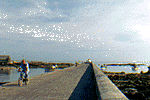 |
On the granite jetty, a man with a sailor's cap is riding a bicycle toward us. Further away, a fisherman is working on his nets. Two fishing boats are just outside the harbor, waiting for the tide to rise a little more to sail in. A short white beacon with a red tip marks the end of the jetty, and across the way, to our left, the village church stands, squat and sturdy, poised against the elements. |
For a moment, everything seems to hang still, like a beautiful photograph. And then, the man on the bicycle rides away, the boats come in, refrigerated trucks move in close to the quay. As soon as the boats are close enough, two sailors jump out, catch a rope, and tie up the boat. Right away, the mussels are unloaded, 100 lb. bag after 100 lb. bag, straight from the boat to the truck.
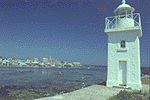 We are in Barfleur, a little village of granite houses on a narrow spit of land. Near the jetty, a white lighthouse, short and square, helps the fishermen find their way into the harbor. It sits right across from the village and we sit for a while on the rocks. It is high tide now, and we gaze at the scene that spreads before us: small fishing boats are anchored in the wide harbor, all facing in the same direction, pushed by the rising tide.
We are in Barfleur, a little village of granite houses on a narrow spit of land. Near the jetty, a white lighthouse, short and square, helps the fishermen find their way into the harbor. It sits right across from the village and we sit for a while on the rocks. It is high tide now, and we gaze at the scene that spreads before us: small fishing boats are anchored in the wide harbor, all facing in the same direction, pushed by the rising tide.
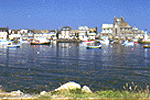 The larger boats, with their brightly painted hulls, are lined up along the quay across the water. A long row of houses, all of gray stone, with white shutters and slate roofs, is broken only by the Café de France, with its façade lined with red bricks and its large awning, and a pretty ivy-covered house near the church.
The larger boats, with their brightly painted hulls, are lined up along the quay across the water. A long row of houses, all of gray stone, with white shutters and slate roofs, is broken only by the Café de France, with its façade lined with red bricks and its large awning, and a pretty ivy-covered house near the church.
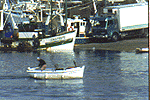 We walk around the harbor, all the way to the point, past the church. A bronze plaque on a large rock at the entrance to the harbor, reminds us that William sailed to England in 1066 in a ship built in Barfleur, the Mora, and that its skipper was a local man named Etienne.
We walk around the harbor, all the way to the point, past the church. A bronze plaque on a large rock at the entrance to the harbor, reminds us that William sailed to England in 1066 in a ship built in Barfleur, the Mora, and that its skipper was a local man named Etienne.
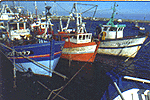 We stop at the Café de France to sip a mid-morning coffee. From the outdoor terrace, we watch the activity around the quay and the boats. We had spent the night a few miles away, at the Manoir de Montfarville, a Bed and Breakfast that dates back to the XVc. Over a breakfast of croissants, fresh bread and jam, the landlady graciously informed us that the house is built on an earthen mound on which originally rose a wooden fort. This was replaced in the XIc by a stone castle, which controlled the land access to Barfleur. The castle was destroyed by the English at the beginning of the Hundred-year War, in July 1346, when King Edward, after landing in Saint-Vaast, ramsacked Barfleur and Cherbourg before marching on Caen.
We stop at the Café de France to sip a mid-morning coffee. From the outdoor terrace, we watch the activity around the quay and the boats. We had spent the night a few miles away, at the Manoir de Montfarville, a Bed and Breakfast that dates back to the XVc. Over a breakfast of croissants, fresh bread and jam, the landlady graciously informed us that the house is built on an earthen mound on which originally rose a wooden fort. This was replaced in the XIc by a stone castle, which controlled the land access to Barfleur. The castle was destroyed by the English at the beginning of the Hundred-year War, in July 1346, when King Edward, after landing in Saint-Vaast, ramsacked Barfleur and Cherbourg before marching on Caen.
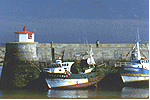 After the conquest of England, Barfleur became one of the main links between Normandy and England, and was the favored port of the nobility when they traveled back and forth between their domains on both sides of the Channel. The town grew to 9000 inhabitants, more than 10 times what it is today.
After the conquest of England, Barfleur became one of the main links between Normandy and England, and was the favored port of the nobility when they traveled back and forth between their domains on both sides of the Channel. The town grew to 9000 inhabitants, more than 10 times what it is today.
After the boats have been unloaded, and the trucks have left, quiet returns to the harbor. We finish our coffee and continue our walk. We enter a narrow alley by the cemetery that surrounds the church. At the end of it, after just a few yards, we are again looking at the sea. We have crossed the tip of the peninsula, and a wide rounded bay opens up before us, punctuated by the high spire of the lighthouse of Gatteville.
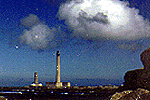 In these waters, in 1120, the Blanche Nef, a ship from Barfleur, got wrecked on the reefs. According to the story, King Henry I, the son of William, was returning to England after spending 4 years in Normandy. With him were his two sons, his court, and several members of prominent European families. A boat captain approached him, claiming to be the son of Etienne, the skipper of the Mora, and proposing his services to the King. Henry already had his royal vessel ready, but he let his sons and part of his court sail with this man. The night before their departure, the ship's crew had been drinking. The next morning, the Blanche Nef left the harbor, and headed straight for the reefs. The first two heirs to the throne drowned in the shipwreck, along with 300 other Nobles.
In these waters, in 1120, the Blanche Nef, a ship from Barfleur, got wrecked on the reefs. According to the story, King Henry I, the son of William, was returning to England after spending 4 years in Normandy. With him were his two sons, his court, and several members of prominent European families. A boat captain approached him, claiming to be the son of Etienne, the skipper of the Mora, and proposing his services to the King. Henry already had his royal vessel ready, but he let his sons and part of his court sail with this man. The night before their departure, the ship's crew had been drinking. The next morning, the Blanche Nef left the harbor, and headed straight for the reefs. The first two heirs to the throne drowned in the shipwreck, along with 300 other Nobles.
Henry's daughter, Maud, married Geoffroy Plantagenet, Duke of Anjou, in 1127. Before his death in 1135, Henry had nominated his nephew, Stephen of Blois, to succeed him, despite Maud's claims to the throne. After 19 years of conflicts, Henry II, son of Maud and Geoffroy, became king in 1154. The Plantagenets would now control England and Normandy, along with most of southwestern France.

